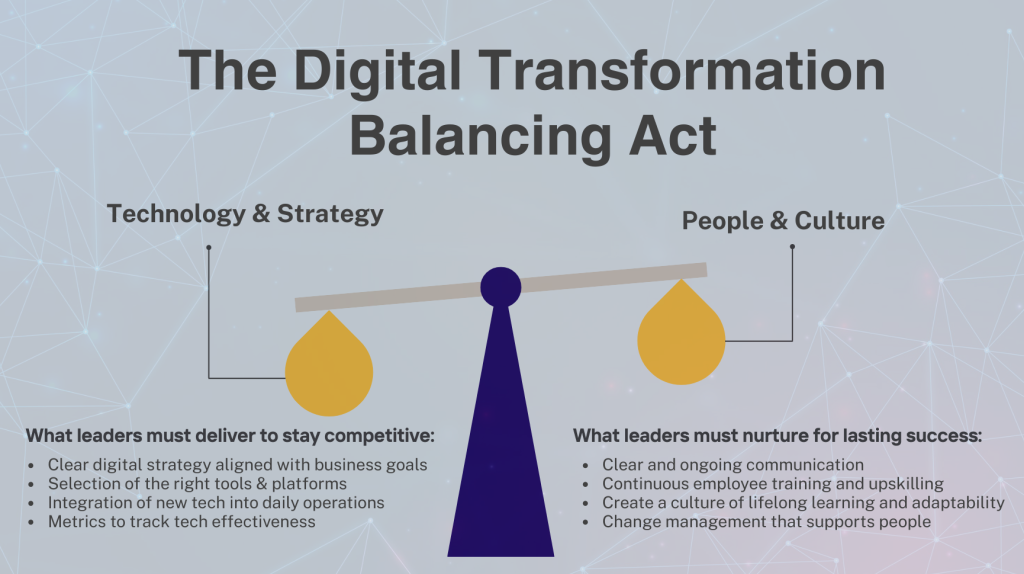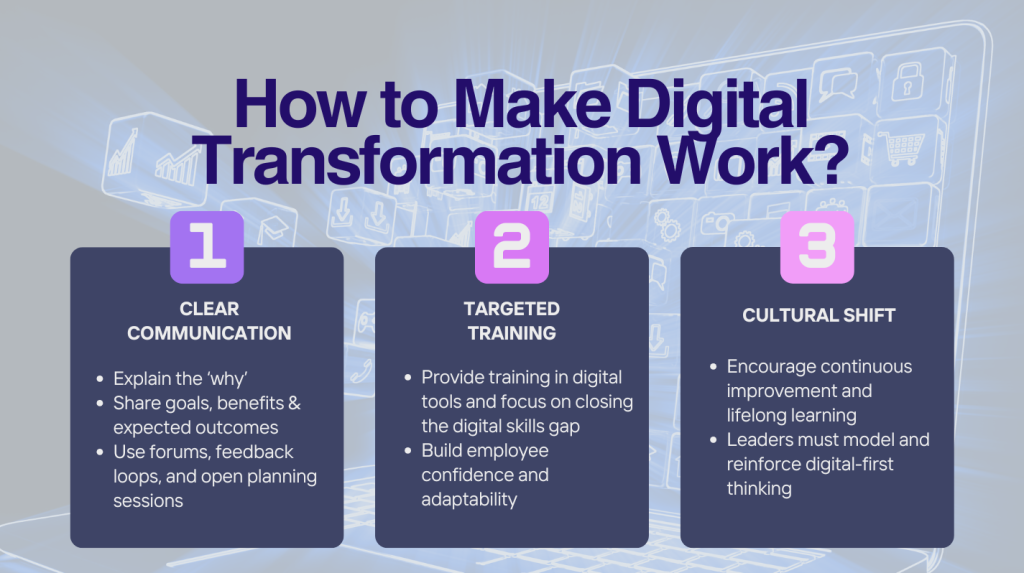Why Are Accounting Firms Still Lagging in Tech Adoption?
In our previous article, we highlighted how accounting is shifting beyond compliance toward a more strategic role. Yet, digital transformation is where the sector risks falling behind. The reality is that the pace of digital adoption is far from uniform. While other industries have embraced automation and data analytics, accounting often remains anchored to legacy systems and siloed ways of working. This week, we want to find out: what’s holding accounting back from digital transformation? From cultural resistance to the complexity of integrating new technologies, we’ll unpack the challenges and highlight why people remain at the heart of digital transformation.
Technology in accounting is moving fast but many firms still struggle to keep up. These new tools can be hard to understand and may not always compatible with older systems. Some employees could be resistant because they worry about losing their jobs to automation or they feel unprepared to use new tools in their daily operations. The combination of tight budgets and growing concerns about data security makes it difficult for firms, especially smaller ones, to invest in new technology.
On top of that, many firms simply don’t have a clear digital transformation plan since they’re focused more on day-to-day operations. Without strong leadership and a culture that supports change, progress stays slow. While some progress has been made, especially during the pandemic, many firms still treat these tech upgrades as an add-on. Despite the clear benefits of innovation, the accounting profession moves cautiously and too slowly.
Buying New Software Won’t Save Your Business
Leaders face a tough balancing act when driving digital transformation. They must keep up to date with new technologies while ensuring their people are supported. On one hand, they need a clear digital strategy, the right tools, and strong systems to stay competitive and meet regulations. On the other, they must build trust, encourage learning, and get everyone’s buy-in.

Simply purchasing new tools doesn’t guarantee digital transformation. Companies can invest in the most advanced accounting software on the market but without the right training, redesigned workflows, and a clear vision, that technology alone won’t help. It will simply sit idle or be used inefficiently, leaving potential value untapped. The software can only be as effective as the people and systems that support it. Progress can only happen when it is integrated into daily operations, staff are retrained and know how to use it, and it is aligned with the overall business strategy.
Culture matters just as much as technology. If new systems don’t fit how people work, they can cause confusion or resistance. Leaders must communicate clearly, manage change well, and invest in training. Success comes from people using it with purpose and confidence. Without clear communication from leaders about how the software aligns with business objectives, teams lack direction and employees struggle to understand its importance. This often leads to fragmented adoption or worse, a costly cycle of abandoning one tool for the next big thing.
What Are The Hidden Barriers?
The most significant barriers to innovation in accounting is surprisingly human. While we often focus on the latest software or AI, the real friction comes from hidden barriers like resistance to change and outdated mindsets.
Imagine you’ve been doing your job the same way for years. You have a routine that works and it’s comfortable. Now, someone wants to introduce a new system that will completely change how you do your work. This is the root of resistance to change. It’s a natural human reaction to the unknown. This is why getting finance and accounting teams to embrace new technology is surprisingly hard, and the reasons have less to do with the tech and more to do with people.
This resistance comes from a mix of very human fears: the fear of losing your job to a computer, the fear that your years of experience will become useless, and the simple anxiety of having to learn a whole new way of working. Considering how finance professionals have built their expertise through years of working, it can feel like a direct challenge to their knowledge and job stability when automation or AI is introduced. As a result, they may resist by avoiding full use of these tools or by actively opposing technological changes.
Ultimately, it’s outdated ways of thinking slow down progress. Many finance and accounting firms have cultures built on caution, meticulousness, and a reliance on established processes. They often view new technology as a risky unknown rather than a tool for advancement. There’s a tendency to stick with familiar methods and this mindset fosters a culture where innovation is considered optional instead of essential. The fast-moving, experimental nature of digital transformation can often feel uncomfortable. People choose to stay within their comfort zones, even when it’s obvious that the world is moving forward. This leads to a recurring pattern where new ideas are talked about but rarely put into action, causing the firm to fall behind.
To some employees, new software is just a different way to do the same task they’ve always done manually. Leaders may not effectively communicate the bigger picture, such as how automation can free up time for more strategic work, how data analytics can unlock new insights, or how integrated systems can streamline workflows. Employees won’t buy in if they can’t see the value or how it connects to the bigger picture.
The Change Management Challenge
Successful digital transformation requires more than software rollouts. It demands communication, training, and long-term cultural shift. These elements are crucial for overcoming human barriers and ensuring that technological improvements translate into real, sustained benefits.

Clear and transparent communication about the goals and benefits of digital transformation helps to reduce resistance and foster buy-in from employees. When employees are not just informed but actively engaged, i.e., through forums, feedback loops, and included in planning, they are more likely to feel invested in the outcome, fostering a sense of ownership and support across the organisation.
Ongoing training programs are essential to equip professionals with the necessary digital skills, such as data analytics and AI. These programs help to reduce the fear of technology, bridge the digital skills gap and boost confidence in using these tools. Through a blend of formal courses and hands-on learning, firms can ensure their teams have the expertise to use new technology effectively, which is key to improving both productivity and flexibility.
At the end of the day, the goal is a long-term cultural shift toward innovation and continuous learning. Building a culture that values innovation, experimentation, and lifelong learning ensures that employees naturally see digital tools as part of the job. It is important for leaders to champion and embed these new values into day to day operations. By aligning organisational values with adaptability and digital readiness, they ensure digital change becomes a continuous process rather than a one-time event.
Closing the Leadership Gap in a Digital World
Leaders are expected to steer their organisations through a digital transformation, but that doesn’t mean they always have the necessary skills to do so. Many accounting and finance leaders are fully aware that change is necessary. They understand the issues and what needs to happen:
- That traditional accounting processes are too slow and rigid
- That automation and AI can dramatically improve efficiency and accuracy
- That cloud platforms, real-time data, and advanced analytics provide a competitive advantage
The real challenge lies in the “how.”
- How do you modernise systems without disrupting operations?
- How do you choose the right tools and make sure they’re used properly?
- How do you upskill and retrain your staff without overwhelming them?
The gap between insight and action (i.e., knowing change is needed but not knowing how to lead it) is where most companies get stuck. Leaders may not know how to choose the right software, how to restructure a team to be more agile, or how to manage the emotional resistance of employees who are comfortable with the old way of doing things. More often than not, leaders lack the digital fluency or the urgency to guide their teams through transformation.
Why People Are More Important Than Ever in a Tech-Driven World
In an increasingly tech-driven world, people still remain the most critical factor in determining whether digital transformation in a company succeeds or fails. The adoption of new technology depend on human willingness to engage, adapt, and lead change. As mentioned earlier, the human side of transformation through clear messaging, upskilling, and cultural change, is what has a real impact.
While new software and fancy equipment can be purchased, its value is only realised through the people who use it with intention. The mindset of employees, their openness to learning, and continuous upskilling will essentially shape how effective these tools are implemented and sustained. Whether it’s navigating unpredictable situations or ensuring data security and privacy, it’s the people in your organisation who will provide the critical thinking and moral compass that technology lacks.
Human-centered design also plays a pivotal role: systems that are intuitive and easy to use are created by people who understand real-world workflows and needs. Equally important are the champions and change agents within organisations who promote adoption, build trust, and align new technologies with company culture. In the end, technology is a tool. Its potential and power is unlocked by the people who design, guide, and use it with purpose.
Conclusion: Preparing For The Future of Work
The future of accounting is not about replacing professionals with machines. Instead, the goal is to equip them with better support. No amount of technology can replace the impact of a workforce that is informed, engaged, and empowered. To move forward, firms must recognise that change comes from within. This means focusing on effective change management: building a culture that welcomes innovation, delivering meaningful training that builds digital confidence, and ensuring leaders actively supports and models a digital-first approach. When people lead the change, technology can become a powerful driver of growth and competitive advantage.
Stay ahead with exclusive insights! Sign up for our mailing list and never miss an article. Be the first to discover inspiring stories, valuable insights and expert tips – straight to your inbox!




